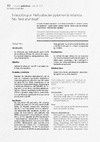Identificador persistente para citar o vincular este elemento:
https://accedacris.ulpgc.es/handle/10553/106866
| Título: | Infección por Helicobacter pylori en la infancia: No “test and treat” | Otros títulos: | Helicobacter pylori infection in pediatric patients: no “test and treat” | Autores/as: | Romero Álvarez, Cristina Peña Quintana, Luis González Santana, Daniel Ramos Varela, Juan Carlos Díaz de Bethencourt Pardo, Rocío Bordón Sardiña, Erik |
Clasificación UNESCO: | 32 Ciencias médicas 320503 Gastroenterología 320110 Pediatría |
Palabras clave: | Dolor abdominal Erradicación Helicobacter pylori Niños Tratamiento, et al. |
Fecha de publicación: | 2020 | Publicación seriada: | Canarias pediátrica | Resumen: | Introducción. La infección por Helicobacter pylori (HP) en la infancia difiere del adulto en aspectos epidemiológicos, patogenéticos, clínicos y terapéuticos.
Objetivo. Valorar la infección por HP y su mejor estrategia terapéutica.
Pacientes y métodos. Estudio de cohortes retrospectivo en el que se incluyeron pacientes pediátricos diagnosticados de infección por HP entre los años 2013 y 2018, controlados en la Unidad de Gastroenterología, Hepatología y Nutrición Pediátrica del CHUIMI. Se recogieron, entre otros, variables epidemiológicas, clínicas, evolutivas, fecha del diagnóstico, pruebas diagnósticas, tratamiento y su eficacia, correlacionándose con la erradicación del HP.
Resultados. Se estudiaron 95 pacientes, 50 varones (52,6%), de entre 2 y 14 años (media 9,65 años). El 96,84% presentaba síntomas, siendo el más frecuente el dolor abdominal recurrente (85 pacientes, 92,4%). La pauta de tratamiento más utilizada fue OMA (omeprazol + metronidazol + amoxicilina; n=73), seguida de OCA (omeprazol + claritromicina + amoxicilina; n=31), siendo la erradicación más frecuente con OMA (57,5%). Observamos que cuantos más ciclos recibían, menor era la erradicación. Tras el tratamiento, de los 74 pacientes asintomáticos, el 45,9% se encontraba en el grupo que había erradicado la infección y el 54,1% al que no la había erradicado (p= 0,365).
Conclusiones. La sintomatología clínica no se relaciona con la infección por Helicobacter pylori. Se debe evitar la estrategia “test and treat” y valorar de forma individual un posible tratamiento erradicador Introduction: In pediatric age groups, HP infection differs from adult infection in epidemiologic aspects, as well as pathogenesis and clinical manifestations. Aims: To carry out a study on HP infection and its best therapeutic strategy. Patients and methods: Retrospective cohort study that included pediatric patients diagnosed with HP infection between 2013 and 2018, and were controlled by the Pediatric Gastroenterology, Hepatology and Nutrition Unit of the Pediatrics Service of the CHUIMI. We collected epidemiologic and clinical variables, date of diagnosis, diagnostic tests, treatment and its efficiency, and the relationship between those and HP erradication. Results: 95 patients were studied, 50 men (52,6%), with age between 2 and 14 (mean 9,65 years). 96,84% were symptomatic, with recurrent abdominal pain being the most frequent symptom of all (85 patients, 92,4%). The type of treatment that was most used is OMA (omeprazole + metronidazole + amoxicillin; n=73), followed by OCA (omeprazole + clarithromycin + amoxicillin; n=31). The eradication was more frequent with OMA (57,5%) than with OCA. We found that the eradication rate decreased as the number of treatment cycles increased. After treatment, from the 74 patients that were asymptomatic, 45,9% were from the group in which eradication was achieved and 54,1% were from the group in which it was not (p= 0,365). Conclusions: Clinical manifestations are not clearly related to the infection by Helicobacter pylori in children. A “test and treat” strategy should be avoided and the need for eradication therapy for each patient should be assessed individually |
URI: | https://accedacris.ulpgc.es/handle/10553/106866 | ISSN: | 1131-6128 | Fuente: | Canarias pediátrica [ISSN 1131-6128], v. 44(2), pp. 90-97 (mayo-agosto 2020) |
| Colección: | Artículos |
Visitas
195
actualizado el 24-ago-2024
Descargas
111
actualizado el 24-ago-2024
Google ScholarTM
Verifica
Comparte
Exporta metadatos
Los elementos en ULPGC accedaCRIS están protegidos por derechos de autor con todos los derechos reservados, a menos que se indique lo contrario.
